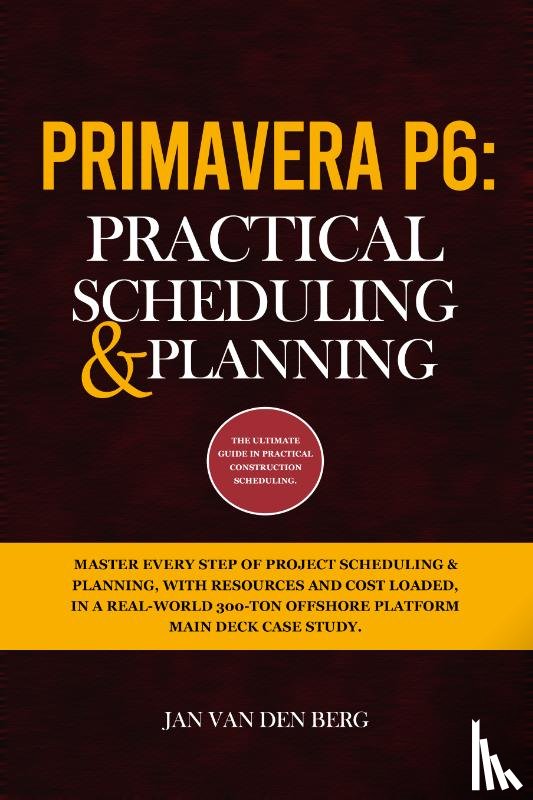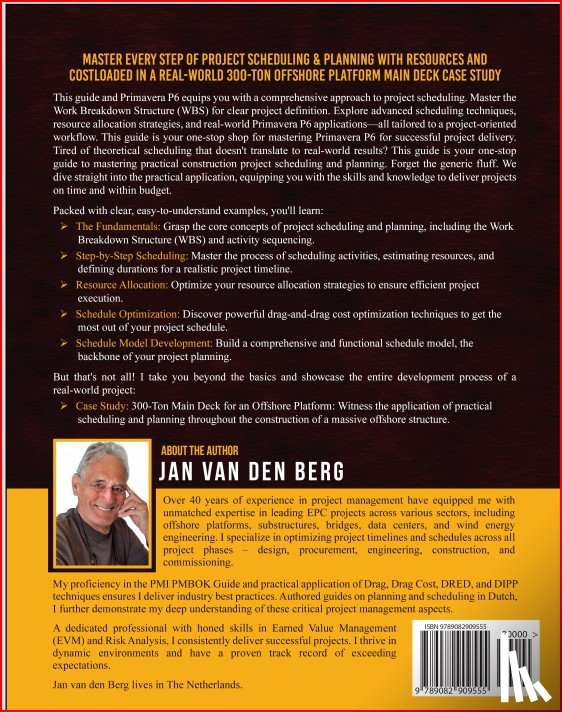Omschrijving
MASTER EVERY STEP OF PROJECT SCHEDULING & PLANNING,
WITH RESOURCES AND COST LOADED, IN A REAL-WORLD 300-TON
OFFSHORE PLATFORM MAIN DECK CASE STUDY. MASTER EVERY STEP OF PROJECT SCHEDULING & PLANNING WITH RESOURCES AND COSTLOADED IN A REAL-WORLD 300 -TON OFFSHORE PLATFORM MAIN DECK STUDY.
This guide and Primavera P6 equips you with a comprehensive approach to project scheduling. Master the Work Breakdown Structure (WBS) for clear project definition. Explore advanced scheduling techniques, resource allocation strategies, and real-world Primavera P6 applications—all tailored to a project-oriented workflow. This guide is your one-stop shop for mastering Primavera P6 for successful project delivery. Tired of theoretical scheduling that doesn't translate to real-world results? This guide is your one-stop guide to mastering practical construction project scheduling and planning. Forget the generic fluff. We dive straight into the practical application, equipping you with the skills and knowledge to deliver projects on time and within budget.
Packed with clear, easy-to-understand examples, you'll learn:
The Fundamentals: Grasp the core concepts of project scheduling and planning, including the Work Breakdown Structure (WBS) and activity sequencing.
Step-by-Step Scheduling: Master the process of scheduling activities, estimating resources, and defining durations for a realistic project timeline.
Resource Allocation: Optimize your resource allocation strategies to ensure efficient project execution.
Schedule Optimization: Discover powerful drag-and-drag cost optimization techniques to get the most out of your project schedule.
Schedule Model Development: Build a comprehensive and functional schedule model, the backbone of your project planning.
But that's not all! I take you beyond the basics and showcase the entire development process of a real-world project:
Case Study: 300-Ton Main Deck for an Offshore Platform: Witness the application of practical scheduling and planning throughout the construction of a massive offshore structure. "Witness the step-by-step construction of a massive 300-ton offshore platform brought to life with 193 In-Action Snapshots"! The ultimate guide in practical construction scheduling. 5
List of Figures 17
PREFACE 25
INTRODUCTION 27
1)The development of the time management plan 28
2) Defining the Activities 28
3) Scheduling the Activities 29
4) Estimating the Resources 29
5) Estimating Activity Duration 29
6) Schedule optimization 29
7) Developing the Project Schedule 30
8) Performance review reporting 30
CHAPTER 1 THE TIME MANAGEMENT PLAN 34
1 )The project mandate 35
2) The project management plan (PMP ) 36
3) The three basic plans 36
Ad 1. Scope base plan 36
Ad 2. Time base plan 37
Ad 3. Basic cost plan 37
3.1 ) The sub plans 38
Quality plan 38
Process improvement plan 38
Personnel plan 38
Communication plan 38
Risk management plan 38
Purchasing plan 39
Stakeholder plan 39
PMP summary 39
4) Business organizational influences on project scheduling 40
Operating environmental factors 40
Business Organization Process Assets 40
The output of the time management plan 41
The development criteria for the scheduling model 41
Requirements analysis 41
Standards and guidelines 41
Levels in scheduling 42
Level 1: strategic milestone scheduling 42
Level 2: Integrated milestone scheduling 42
Level 3: Integrated project scheduling 42
Level 4: implementation scheduling 43
Plans for organizations 43
Ad 1. Functional or line organization 43
Ad 2. Matrix organization 43
Ad 3. Project organization 44
Scheduling summary for organizations 44
Scheduling methods 44
Critical Path Method (KPM), Precedence Diagram Method 45
Critical Chain Method (CCM) 46
Dynamic Scheduling Method (DSM) 48
Resource Constraint Scheduling: Understanding the Challenges and Solutions 51
Summary of Resource-constrained Scheduling. 52
Summary scheduling methods 52
Scheduling techniques 52
Rolling Wave technique. Navigating the Waves 52
Agile technique 54
Three Points Estimate technique 54
Monte Carlo simulation technique 54
Summary scheduling techniques 54
Scheduling tools 55
Traditional scheduling tools 55
Modern scheduling tools 56
Types of Scheduling 56
Portfolio scheduling 56
Program scheduling 57
Project scheduling 57
Offer or tender scheduling 57
Engineering scheduling 57
Purchasing scheduling 57
Manufacturing, execution, or production scheduling 57
Assembly scheduling 57
Test and verification scheduling 58
Commissioning scheduling 58
Key Takeaways of the Time Management Plan 58
CHAPTER 2 DEFINING THE ACTIVITIES 60
Inputs for the process define activities. 60
Time management plan 61
Scope baseline 61
Work Breakdown Structure 62
Statement of Work 62
Work packages 63
The environmental factors of the company 63
Tools and techniques for defining the activities 64
Decomposition techniques 65
Scheduling methods, types, and techniques 65
Subject Matters Expert (SME), i.e., experts or experts 65
The output of defining the activities 65
Example: Main deck for an offshore platform 65
Statement of Work (SOW) for creating the main deck of the topsides 66
SOW graphically depicted 66
Building the Work Breakdown Structure 70
Fragnet 76
CHAPTER 3 SCHEDULING THE ACTIVITIES 77
Input for scheduling the activities 77
Ad 1. Time management plan 78
Ad 2. Activity list 78
Ad 3. Activity attributes 78
Ad 4. Milestone list 78
Ad 5. Project scope statement 78
Ad 6. Operating environmental factors 78
Ad 7. Company-dependent assets 78
Tools and techniques 78
Scheduling methods and techniques 79
Critical Path Method (KPM), Precedence Diagram Method 79
Standard relations 79
Finish-to-Start Relationship (FS Relationship) 80
Start-to-Start Relationship (SS Relationship) 80
Finish-to-Finish Relationship (FF Relationship) 80
Start-to-Finish relationship (SF relationship) 81
Special relationships 81
Lead relationship 81
Lag relationship 81
Determine the dependencies 81
Required Provisions 82
Preferences 82
External Provisions 82
Internal provisions 82
Techniques for collaboration and cooperation 82
Brainstorm 83
Mind mapping 83
Collaboration Tools 83
Critical takeaways for scheduling the activities 84
Example: Maindeck for an offshore platform 85
Statement of Work (SOW) for creating the main deck of the topsides 85
SOW graphically depicted 85
Work Breakdown Structure 87
Production engineering 89
CHAPTER 4 ESTIMATING THE RESOURCES 93
1. Project scheduling, grading, and accuracy 93
The cost-base plan 94
Units of measurement 94
Accuracy level 94
Cost Breakdown 94
Control thresholds 94
Performance measurements 95
Reports 95
Cost Base Plan Summary 95
2. Input, tools and techniques, and output 95
Resource estimation 96
Resource calendars 96
Default Calendar 96
Two-shift calendar 96
Three-shift calendar 96
24/7 calendar 96
Individual calendars 96
Holidays and days off 96
Risk register 96
Activity Cost Estimate 97
Tools and techniques 97
Expert view ('expert judgment') 97
Estimating techniques 97
Analog estimation 97
Parametric estimation 98
Bottom-up estimation 98
3. Published estimating data 98
Internal databases for estimating 98
Externally published estimating data. 99
Project management software 99
Resource Library 99
Physical Breakdown Structure (PBS ) 101
Standard Activity Breakdown (SAB) 101
Code Of Resource (COR) 101
Examples of estimation 106
Parametric estimation of the main deck 106
Example calculation 106
Calculation of the required man-hours 106
Indirect hours 107
Materials 107
Equipment 107
Bottom-up estimating 108
Standards and key figures 108
Examples of bottom-up estimation 108
Process estimates in Primavera P6 111
Direct man hours 111
Example resource library as created in Primavera 112
Examples in Primavera 113
Pre-assemble main deck AA 114
Assemble the main deck. 115
Protective coating 116
Summary examples 117
CHAPTER 5 ESTIMATING THE DURATION 118
Duration of an activity 118
What do the international standards and standard practices say? 119
14- Points Assessment Check Protocol 119
The Society of Construction Law & Delay and Disruption Protocol 119
My preference for the maximum duration of an activity 119
Input, tools and techniques, and output 120
Input for estimating the activity duration 120
Resource calendars 121
Project scope statement 122
Milestones 122
Key dates and internal milestones 122
Billing Milestones 122
Delivery times of the deliverables 123
Availability of the resources 123
Global and project-specific calendars 123
Holidays and days off 123
Availability of the work sites and buildings 123
Forced obstructions of, for example, roads, railways, and waterways 123
Climatic conditions 124
Risk register 124
Operating environmental factors 124
Business dependent assets 124
Tools & Techniques 124
Three Point Estimation 124
Beta distribution 125
( Program Evaluation and Review Technique. 125
Statistical PERT (SPERT) 125
Group decision-making techniques 126
DELPHI technique 126
How does it work in practice? 127
Tools 127
Reserve analyses 127
Quantitative analysis time buffers 128
Output 128
Activity duration estimate 128
Project document updates 128
Estimate examples 128
Example1: Determining the activity duration for the main deck 129
Production engineering 129
Crop prep. all parts 130
Preassembling all parts 131
Assembling the main deck 131
Shotblasting and Painting 132
Final assembling of the main deck 132
CHAPTER 7 SCHEDULE OPTIMIZATION 134
Tracking investment value and progress 155
CHAPTER 8 DEVELOPING THE PROJECT SCHEDULE 169
Input, tools and techniques, and the output 169
Tools and techniques 170
Project scheduling network analysis 171
Critical path method 171
Summary limitations and constraints 182
Critical Chain Method 183
Resource optimization techniques 184
Resource leveling (leveling) 184
Resource leveling example 185
Resource smoothing (smoothing) 188
Resource leveling example 189
Modeling Techniques ( What-If) 190
Simulation techniques 190
Verification, review, and approval 197
External requirements for a schedule 197
DCMA 14 Point Assessment 206
Summary tools and techniques 208
Coding of the schedule 209
Coding the project schedule 209
NORSOK codes 209
Other code options s 210
Add costs to the project schedule 210
Cost allocation introduction 210
Choices we have to make 211
External and internal cost management 218
Cost control to the client 218
Internal cost control 218
Sample Control Account Plans (CAPs) 220
Approval of the project schedule 225
Risk and reserve analyses for this work package 226
Signing the project schedule 227
Presenting the Project schedule 228
Example 1: Developing the Main deck project schedule 229
Requirement for a good schedule 229
Categories 2: Resource Required Components (RRC) 237
Drag and drag cost optimization. 261
Category 3: Earned Value Scheduling 266
High-Level cost overview 266
Finalizing the development of the project schedule 275
CHAPTER 9 PERFORMANCE REVIEW REPORTING 278
BIBLIOGRAPHY 293
Guides 293
Websites 294
INDEX 295




